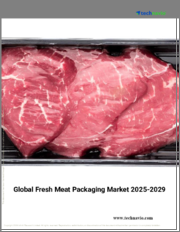
|
시장보고서
상품코드
1410124
세계의 육류 포장 시장 : 예측(2023-2028년)Meat Packaging Market - Forecasts from 2023 to 2028 |
||||||
세계의 육류 포장(Meat Packaging) 시장 규모는 예측 기간 동안 CAGR 2.83%로 추이하며 성장할 것으로 예측됩니다.
육류 포장은 육류 제품의 신선도, 안전성 및 진열을 보장하기 위해 포장하고 밀봉하는 과정을 말합니다. 일반적으로 진공 밀봉 비닐백, 가스치환 포장(MAP) 또는 흡수 패드가 있는 트레이와 같은 특수 소재를 사용합니다. 포장은 육류를 오염으로부터 보호하고, 유통기한을 연장하며, 부패를 방지하고, 소비자가 편리하게 취급하고 보관할 수 있도록 하는 등 다양한 용도로 사용됩니다. 또한 육류를 적절히 포장하면 영양 정보, 제품 식별 및 취급 지침을 포함한 효과적인 라벨링을 할 수 있습니다. 전반적으로 육류 포장은 농장에서 식탁까지 육류 제품의 품질과 무결성을 보존하는 데 중요한 역할을 합니다.
소개
육류 포장 시장은 육류 제품을 위해 특별히 설계된 포장재 및 솔루션의 제조, 유통, 판매와 관련된 산업을 말합니다. 여기에는 필름, 트레이, 진공 밀봉 백, 용기 등 다양한 유형의 포장재를 포함한 광범위한 제품 및 서비스가 포함됩니다. 이 시장은 포장육 및 가공육에 대한 수요 증가, 식품 안전 및 위생에 대한 우려 증가, 유통기한 연장 및 편의성에 대한 필요성 등 요인에 의해 주도되고 있습니다. 육류 포장 시장의 기업들은 공급망 전반에 걸쳐 제품의 품질과 무결성을 유지하면서 소비자의 기대와 규제 요건을 충족하기 위해 혁신적이고 지속 가능한 포장 솔루션을 개발하기 위해 노력하고 있습니다.
촉진 요인
포장 육류에 대한 수요 증가 :
편의성과 바로 먹을 수 있는 육류 제품에 대한 소비자 선호도가 높아지면서 제품의 신선도, 안전성, 사용 편의성을 보장하는 효과적인 포장 솔루션에 대한 수요가 증가하고 있습니다.
세계의 육류 소비 확대 :
전 세계 인구가 계속 증가함에 따라 육류에 대한 수요도 증가하고 있습니다. 이러한 수요 증가는 육류 포장 시장이 더 많은 소비자층의 포장 요구 사항을 충족할 수 있는 기회를 창출합니다.
식품 안전 및 위생에 대한 우려 :
소비자들은 식품 안전과 위생에 대한 의식이 점점 더 높아지고 있습니다. 적절한 육류 포장은 육류를 오염으로부터 보호하고 품질을 보장하며 식품 매개 질병의 확산을 방지하는 데 중요한 역할을 합니다.
유통 기한 연장 :
포장 재료와 기술은 육류 제품의 유통기한을 연장하여 음식물 쓰레기를 줄이고 유통 및 보관 기간을 연장하는 데 도움이 될 수 있습니다. 이러한 측면은 소매업체와 소비자 모두에게 필수적입니다.
규정 준수 :
육류 포장에는 제품 안전성, 라벨링 정확성 및 추적성을 보장하기 위해 엄격한 규정과 표준이 적용됩니다. 기업은 이러한 규정을 준수해야 하므로 규정 준수 요건을 충족하는 포장 솔루션에 대한 수요가 증가하고 있습니다.
제품 차별화 및 브랜드화 :
육류 제조업체는 포장을 통해 제품을 차별화하고 브랜드 인지도를 높일 수 있습니다. 포장의 눈길을 사로잡는 디자인, 라벨링, 브랜딩 요소는 소비자의 구매 결정에 영향을 미칠 수 있습니다.
지속가능성 및 환경 문제 :
환경 문제에 대한 인식이 높아지면서 지속 가능한 포장 솔루션에 대한 수요가 증가하고 있습니다. 육류 포장 시장은 이러한 우려를 충족하기 위해 친환경 소재, 재활용 가능한 포장 옵션, 포장 폐기물 감소를 모색하고 있습니다.
편의성 및 휴대성 :
소비자들은 이동 중 소비나 소규모 가구를 위해 편리하고 휴대 가능한 육류 포장 옵션을 찾습니다. 양 조절, 재밀봉성, 간편한 취급을 제공하는 포장 솔루션은 이러한 소비자의 요구를 충족합니다.
전자상거래 및 온라인 소매 :
전자상거래와 온라인 소매업의 성장으로 육류 포장 시장이 확대되었습니다. 온라인 판매자는 운송 중 육류를 보호하고 신선도를 유지하며 배송 시 매력적인 프레젠테이션을 제공하는 포장 솔루션이 필요합니다.
기술 진보 :
가스치환포장(MAP), 액티브 및 지능형 포장 시스템, 항균 필름과 같은 포장 기술의 발전으로 제품 보존, 품질 보증, 유통기한이 연장되었습니다.
주요 기업이 제공하는 제품 :
Volpi Foods는 플라스틱 사용량을 80% 줄인 첨단 생고기 포장의 새로운 라인을 출시했습니다. 이 새로운 포장은 종이로 만들어져 얇은 라이너에서 분리하면 곡선 측면에서 재활용 가능합니다. 인도의 슈퍼 로컬 옴니 채널 육류 브랜드 Nandu's는 모든 택배 주문을 위해 완전히 재활용 가능한 비 플라스틱 처녀 식품 등급 재료로 만든 혁신적인 친환경 포장을 출시했습니다. 이탈리아의 가족 경영 브랜드인 키올라는 플라스틱 사용량을 80% 줄인 포장 식육 제품 라인을 출시했습니다. 이 새로운 포장은 암 코어 VAC(TM)와 ICE(TM)의 맞춤형 성형 필름 및 판지 외장 랩의 조합으로 만들어집니다.
지속 가능하고 환경 친화적인 부문으로 플러스 성장 :
지속가능하고 환경친화적인 육류포장 부문는 육류포장 시장에서 급속한 플러스 성장을 이루고 있습니다. 이 성장은 환경 친화적인 포장 솔루션에 대한 소비자 수요 증가로 인한 것입니다. 소비자는 포장 폐기물이 환경에 미치는 영향을 의식하게 되어 지속 가능한 대체품을 요구하게 되었습니다. 기업은 재활용 가능하고 생분해성이 뛰어나고 재생 가능한 자원으로 만들어진 포장 재료와 솔루션을 개발함으로써 이 수요에 부응하고 있습니다. 지속가능성의 중요성은 소비자의 가치에 부합하고 브랜드의 명성을 높이기 때문에 시장 세분화는 이 부문의 급성장을 이끌어 가고 있습니다.
아시아 태평양이 큰 점유율을 차지할 것으로 예상
아시아 태평양은 식육 소비 증가, 식량 안전 및 품질에 대한 주목, 주요 육류 가공 기업의 존재로 육류 포장 시장을 독점하는 태세를 갖추고 있습니다. 중간층 증가, 도시화, 건강상의 이점에 대한 인식 등 요인이 식육제품 수요를 촉진하고 있습니다. 엄격한 식품 안전 규정을 충족시키기 위해 혁신적이고 지속 가능한 포장 솔루션이 필요합니다. 이 지역의 주요 시장에는 중국, 인도, 일본, 한국, 인도네시아가 포함됩니다.
주요 발전 :
2023년 7월 샤르큐토리를 생산하는 Volpi Foods는 첨단 생고기용 플라스틱 사용량을 줄이는 에코팩이라는 새로운 포장을 출시했습니다. 이 포장은 재활용 가능한 종이 소재를 사용하며 기존 포장 및 동일한 유통 기한을 유지합니다. 2022년 1월, 소비자 제품을 생산하는 Tekni-Plex는 발포 폴리프로필렌(FPP) 식품 트레이를 도입하여 신선한 고기와 청과물 포장 옵션을 제공합니다. 이러한 FPP 트레이는 기존의 폴리프로필렌(PP) 분류 공정에서 쉽게 재활용할 수 있기 때문에 기존의 발포 폴리스티렌(FPS) 트레이를 대체할 수 있는 지속가능한 대안으로서의 역할을 합니다.
목차
제1장 서론
- 시장 개요
- 시장 정의
- 조사 범위
- 시장 세분화
- 통화
- 전제 조건
- 기준연도 및 예측연도의 타임라인
제2장 조사 방법
- 조사 디자인
- 조사 데이터
- 검증
제3장 주요 요약
- 주요 조사 결과
제4장 시장 역학
- 시장 성장 촉진 요인
- 시장 성장 억제 요인
- Porter's Five Forces 분석
- 산업 밸류체인 분석
제5장 육류 포장 시장 : 포장 재료 유형별
- 소개
- 플라스틱
- 금속
- 알루미늄
- 강철
- 기타
- 기타
제6장 육류 포장 시장 : 제품 유형별
- 소개
- 플렉서블
- 파우치
- 가방
- 필름·랩
- 기타
- 딱딱한
제7장 육류 포장 시장 : 고기유형별
- 소개
- 신선품·냉동품
- 가공품
제8장 육류 포장 시장 : 지역별
- 소개
- 북미
- 미국
- 캐나다
- 멕시코
- 남미
- 브라질
- 아르헨티나
- 기타
- 유럽
- 영국
- 독일
- 프랑스
- 이탈리아
- 스페인
- 기타
- 중동 및 아프리카
- 사우디아라비아
- 아랍에미리트(UAE)
- 기타
- 아시아 태평양
- 일본
- 중국
- 인도
- 한국
- 대만
- 태국
- 인도네시아
- 기타
제9장 경쟁 환경 및 분석
- 주요 기업 및 전략 분석
- 스타트업 및 시장 수익성
- 합병, 인수, 합의 및 협업
- 벤더 경쟁력 매트릭스
제10장 기업 개요
- Amcor Plc
- Berry Global Inc.
- Sonoco Products Company
- Mondi PLC
- Sealed Air Corporation
- Smurfit Kappa Group
- Coveris Holding SA
- Winpak Ltd.
- Crown Holdings Inc.
- Viscofan Group
The meat packaging market is estimated to grow at a CAGR of 2.83% during the forecast period.
Meat packaging refers to the process of wrapping and sealing meat products to ensure their freshness, safety, and presentation. It typically involves the use of specialized materials such as vacuum-sealed plastic bags, modified atmosphere packaging (MAP), or trays with absorbent pads. The packaging serves multiple purposes, including protecting the meat from contamination, extending its shelf life, preventing spoilage, and providing convenient handling and storage for consumers. Properly packaged meat also allows for effective labelling, including nutritional information, product identification, and handling instructions. Overall, meat packaging plays a vital role in preserving the quality and integrity of meat products from farm to table.
Introduction:
The meat packaging market refers to the industry involved in the manufacturing, distribution, and sale of packaging materials and solutions specifically designed for meat products. It encompasses a wide range of products and services, including various types of packaging materials like films, trays, vacuum-sealed bags, and containers. The market is driven by factors such as increasing demand for packaged and processed meat, growing concerns regarding food safety and hygiene, and the need for extended shelf life and convenience. Companies within the meat packaging market strive to develop innovative and sustainable packaging solutions to meet consumer expectations and regulatory requirements while maintaining product quality and integrity throughout the supply chain.
Drivers:
Increasing Demand for Packaged Meat:
The rising consumer preference for convenience and ready-to-eat meat products drives the demand for effective packaging solutions that ensure product freshness, safety, and ease of use.
Growing Global Meat Consumption:
As the global population continues to grow, so does the demand for meat. This increasing demand creates opportunities for the meat packaging market to cater to the packaging needs of a larger consumer base.
Food Safety and Hygiene Concerns:
Consumers are becoming more conscious about food safety and hygiene. Proper meat packaging plays a crucial role in protecting meat from contamination, ensuring its quality, and preventing the spread of food-borne illnesses.
Extended Shelf Life:
Packaging materials and technologies can help extend the shelf life of meat products, reducing food waste and enabling longer distribution and storage periods. This aspect is essential for both retailers and consumers.
Regulatory Compliance:
Stringent regulations and standards govern meat packaging to ensure product safety, labeling accuracy, and traceability. Companies must adhere to these regulations, driving the demand for packaging solutions that meet compliance requirements.
Product Differentiation and Branding:
Packaging allows meat manufacturers to differentiate their products and enhance brand recognition. Eye-catching designs, labeling, and branding elements on packaging can influence consumer purchasing decisions.
Sustainability and Environmental Concerns:
Increasing awareness of environmental issues has led to a demand for sustainable packaging solutions. The meat packaging market is exploring eco-friendly materials, recyclable packaging options, and reduced packaging waste to meet these concerns.
Convenience and Portability:
Consumers seek convenient and portable meat packaging options for on-the-go consumption or smaller households. Packaging solutions that offer portion control, resealability, and easy handling meet these consumer demands.
E-commerce and Online Retail:
The growth of e-commerce and online retail has expanded the market for meat packaging. Online sellers require packaging solutions that protect meat during transit, maintain freshness, and provide an attractive presentation upon delivery.
Technological Advancements:
Advances in packaging technologies, such as modified atmosphere packaging (MAP), active and intelligent packaging systems, and antimicrobial films, provide enhanced product preservation, quality assurance, and extended shelf life.
Products offered by key companies:
- Volpi Foods launched a new line of premium cured meats packaging that reduces plastic use by 80%. The new packaging is made from a paper material that is curbside recyclable once separated from its thin liner.
- Nandu's, a hyperlocal and omni-channel meat brand in India, launched innovative eco-friendly packaging for all its home delivery orders that are made from a non-plastic virgin food-grade material that is fully recyclable.
- Chiola, a family-owned brand in Italy, launched a line of meat products in packaging with 80% less plastic. The new packaging is made from a combination of Amcor's VAC™ and ICE™ custom-engineered forming films, combined with a paperboard exterior wrap.
Positive growth in the sustainable and eco-friendly segment:
The segment of sustainable and eco-friendly meat packaging is experiencing rapid positive growth within the meat packaging market. This growth can be attributed to the increasing consumer demand for environmentally responsible packaging solutions. As consumers become more conscious of the environmental impact of packaging waste, they seek out sustainable alternatives. Companies are responding to this demand by developing packaging materials and solutions that are recyclable, biodegradable, and made from renewable resources. The focus on sustainability aligns with consumer values and enhances brand reputation, leading to the rapid growth of this segment within the meat packaging market.
The Asia-pacific region is expected to hold a significant share:
The Asia-Pacific region is poised to dominate the meat packaging market due to rising meat consumption, a focus on food safety and quality, and the presence of major meat processing companies. Factors such as a growing middle class, urbanization, and awareness of health benefits are driving the demand for meat products. To meet stringent food safety regulations, there is a need for innovative and sustainable packaging solutions. Key markets in the region include China, India, Japan, South Korea, and Indonesia.
Key developments:
- In July 2023, Volpi Foods, a charcuterie producer, launched new packaging called Eco-Pack that reduces plastic use for its premium cured meats. The packaging utilizes a curbside recyclable paper material, maintaining the same shelf life as the previous packaging.
- In January 2022, Tekni-Plex a consumer-based product producer is introducing foam polypropylene (FPP) food trays to provide packaging options for fresh meat and produce. These FPP trays serve as a sustainable alternative to conventional foam polystyrene (FPS) trays, as they are readily recyclable in existing polypropylene (PP) sorting processes.
Key Segments:
By Packaging Material Type:
- Plastic
- Metal
- Aluminum
- Steel
- Others
- Others
By Product Type:
- Flexible
- Pouches
- Bags
- Films and Wraps
- Others
- Rigid
By Type of Meat
- Fresh and Frozen
- Processed
By Geography
- North America
- United States
- Canada
- Mexico
- South America
- Brazil
- Argentina
- Others
- Europe
- United Kingdom
- Germany
- France
- Italy
- Spain
- Others
- Middle East and Africa
- Saudi Arabia
- UAE
- Others
- Asia Pacific
- Japan
- China
- India
- South Korea
- Taiwan
- Thailand
- Indonesia
- Others
TABLE OF CONTENTS
1. INTRODUCTION
- 1.1. Market Overview
- 1.2. Market Definition
- 1.3. Scope of the Study
- 1.4. Market Segmentation
- 1.5. Currency
- 1.6. Assumptions
- 1.7. Base, and Forecast Years Timeline
2. RESEARCH METHODOLOGY
- 2.1. Research Design
- 2.2. Research Data
- 2.3. Validation
3. EXECUTIVE SUMMARY
- 3.1. Key Findings
4. MARKET DYNAMICS
- 4.1. Market Drivers
- 4.2. Market Restraints
- 4.3. Porter's Five Forces Analysis
- 4.3.1. Bargaining Power of Suppliers
- 4.3.2. Bargaining Power of Buyers
- 4.3.3. Threat of New Entrants
- 4.3.4. Threat of Substitutes
- 4.3.5. Competitive Rivalry in the Industry
- 4.4. Industry Value Chain Analysis
5. MEAT PACKAGING MARKET, BY PACKAGING MATERIAL TYPE
- 5.1. Introduction
- 5.2. Plastic
- 5.3. Metal
- 5.3.1. Aluminum
- 5.3.2. Steel
- 5.3.3. Others
- 5.4. Others
6. MEAT PACKAGING MARKET, BY PRODUCT TYPE
- 6.1. Introduction
- 6.2. Flexible
- 6.2.1. Pouches
- 6.2.2. Bags
- 6.2.3. Films and Wraps
- 6.2.4. Others
- 6.3. Rigid
7. MEAT PACKAGING MARKET, BY TYPE OF MEAT
- 7.1. Introduction
- 7.2. Fresh and Frozen
- 7.3. Processed
8. MEAT PACKAGING MARKET, BY GEOGRAPHY
- 8.1. Introduction
- 8.2. North America
- 8.2.1. United States
- 8.2.2. Canada
- 8.2.3. Mexico
- 8.3. South America
- 8.3.1. Brazil
- 8.3.2. Argentina
- 8.3.3. Others
- 8.4. Europe
- 8.4.1. United Kingdom
- 8.4.2. Germany
- 8.4.3. France
- 8.4.4. Italy
- 8.4.5. Spain
- 8.4.6. Others
- 8.5. Middle East and Africa
- 8.5.1. Saudi Arabia
- 8.5.2. UAE
- 8.5.3. Others
- 8.6. Asia Pacific
- 8.6.1. Japan
- 8.6.2. China
- 8.6.3. India
- 8.6.4. South Korea
- 8.6.5. Taiwan
- 8.6.6. Thailand
- 8.6.7. Indonesia
- 8.6.8. Others
9. COMPETITIVE ENVIRONMENT AND ANALYSIS
- 9.1. Major Players and Strategy Analysis
- 9.2. Emerging Players and Market Lucrativeness
- 9.3. Mergers, Acquisitions, Agreements, and Collaborations
- 9.4. Vendor Competitiveness Matrix
10. COMPANY PROFILES
- 10.1. Amcor Plc
- 10.2. Berry Global Inc.
- 10.3. Sonoco Products Company
- 10.4. Mondi PLC
- 10.5. Sealed Air Corporation
- 10.6. Smurfit Kappa Group
- 10.7. Coveris Holding S.A
- 10.8. Winpak Ltd.
- 10.9. Crown Holdings Inc.
- 10.10. Viscofan Group

















